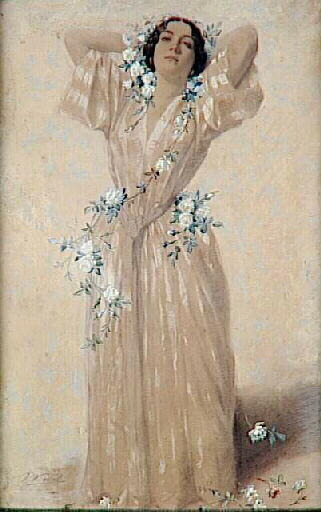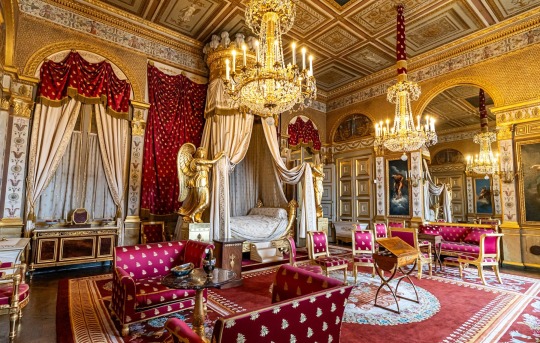#Château de Compiègne
Explore tagged Tumblr posts
Text

"Portrait de Madame Sabatier"
By Vincent Vidal
Watercolor & Guache Painting, c. 1850
Château de Compiègne.
Keep Reading: History/See Also, and then a huge somewhat disclaimer and the very end...
======= HISTORY / SEE ALSO ===>>
Surprisingly, I didn't know Apollonie Sabatier was such a muse. I mean, she was a painter's model, sung opera, and was the child of a Count (except she inherited her step-father's surname, sooooo...). Like above's portrait of her, I had posted in 2023 a painting she's *supposedly* featured in--titled L'Atelier du peintre by Gustave Courbet (I'm not putting the full title because it's long asf)--where she stands with Alfred Mosselman, her perennial fling🙂↕️😏.
Also, fun fact, she died of influenza on my birthday. Now I can brag that Aglaé Joséphine Savatier, French entertainer and muse, and Alois Schicklgruber, Austrian civil servant and (most important of all) father of Adolf Hitler exited Earth the same month and day I have entered it. Lovely.
======= DISCLAIMER?===>>
It's hard to find certain information whenever I do art posts because I tend to find art I enjoy (and can tell a story for) rather than repost well-known subjects, paintings, etc.
So, first off--why I'm mentioning this--the date isn't confirmed. I went through a plethora of resources and couldn't find a specific date other than 1850, but this was created in the 19th century (please don't rely on that, I think it looks a bit cleaner than having 'c. 19th century.' Tell me your opinion, whoever may be reading this, because I'll change it in a heartbeat.
Secondly, I stole this image off of one of those god awful art repost websites where they sell prints. Reason being: better quality. I did chop off a bit of the top, so this isn't *technically* the full painting, but it was only a few pixels.

Here is the photo almost every website uses. Please beat me with a bindle full of twigs if I have caused anybody severe emotional damage over this fiasco </3 But don't sue me because I'm poor :D !!!
#art#artwork#painting#history#aesthetic#oil painting#victorian#19th century#french#19th century painting#guache#traditional art#watercolor#watercolor art#vincent vidal#apollonie sabatier#portrait#1800s#mid 1800s#flowers#white#Château de Compiègne#my posts
20 notes
·
View notes
Text



Aurora, Anne-Louis Girodet-Trioson, 1814-15
#Château de Compiègne#aurora#anne louis girodet de roussy trioson#19th century#art history#art#aesthethic#painting#french art#ancient greece#greek mythology
23 notes
·
View notes
Text






Château de Compiègne, Compiègne, France. (Photo 1: Frank Burchert).
#france#compiegne#chateau#château#palace#compiègne#château de compiègne#chateau de compiegne#sanjaangie#ile de france#interieurs#interiors#castle
2 notes
·
View notes
Text

18th-century Château de Compiègne, Picardy region of northern France
French vintage postcard
#historic#18th-century#chteau#photo#briefkaart#vintage#region#th#sepia#compigne#photography#château de compiègne#carte postale#postcard#postkarte#france#postal#tarjeta#northern#ansichtskarte#french#old#ephemera#de#postkaart#century#picardy
4 notes
·
View notes
Text

The Empress Eugénie surrounded by her ladies-in-waiting (1855) by Franz Xaver Winterhalter. Château de Compiègne.
#franz xaver winterhalter#château de compiègne#compiègne#musée national de palais de compiègne#museums#paintings#women in art#female portrait#empress eugenie#napoleon iii#artwork#painting#art history#europe#history of art#oil painting#oil on canvas#19th century art#19th century#second french empire#french royalty#french royal family#french nobility#european nobility#nobility#belle epoque#fashion history#historical fashion#1850s#1850s fashion
0 notes
Text





France 2019
#compiègne#château de compiègne#château#jardin#oise#hauts de france#france#france tourisme#france tourism#travel#travel photography
1 note
·
View note
Text
Branche & Ciné 2025 : une programmation unique au cœur des forêts
Le festival Branche & Ciné, organisé par l’Office national des forêts, revient pour une 7e édition au cœur des forêts du 27 juin au 12 juillet 2025. Bulles de Culture vous en dit plus. Continue reading Branche & Ciné 2025 : une programmation unique au cœur des forêts
#Alan Rickman#ANIMATION#Branche & Ciné#Captain Fantastic#Château de Pierrefonds#David Lowery#Forêt domaniale de Compiègne#Forêt domaniale de Fontainebleau#Forêt domaniale de La Grange#Forêt domaniale de Meudon#Forêt domaniale de Retz#Hayao Miyazaki#Jaume Collet-Serra#Jungle Cruise#Le mal n&039;existe pas#Les Jardins du roi#Matt Ross#Office national des forêts (ONF)#Peter et Elliott Le Dragon#Princesse Mononoke#Ryûsuke Hamaguchi#Tuilerie de Bezanleu
0 notes
Text

Château de Compiègne, Compiègne, France
Frank Burchert Photography
#art#design#architecture#history#luxury lifestyle#style#luxury house#interior design#luxuey home#staircase#grand staircase#chateau#castle#compiègne#france#frank burchert#napoleon bonaparte
533 notes
·
View notes
Text

Ernest Meissonier - Les Ruines du palais des Tuileries - château de Compiègne (1870s)
285 notes
·
View notes
Text

The Imperial Prince riding his favorite pony
By Olivier Pichat
(History)
The Prince Imperial was trained in equestrian art by a loyal follower of the Emperor, Auguste Bachon, who quickly became his personal equerry. His daily training began at a very young age, as shown in a famous photograph by Mayer and Pierson, where the prince is tied to the saddle of his pony at the riding school on the Quai d'Orsay.This painting by Pichat, probably his first equestrian portrait, depicts him at around the age of four, already very confident on his mount. It was composed from two photographs taken by Mayer and Pierson at Fontainebleau on June 24, 1860.
One shows the child mounted on the same pony in front of the Gros Pavillon, the other seated on a chair, holding a boater hat. This second shot was likely staged specifically for the execution of the canvas. It was on this that the artist relied to portray the Prince Imperial, reproducing his pose, except for the crossed legs and his clothing. The prince is notably wearing a red striped kilt. Having Scottish origins, Empress Eugenie had traveled to Scotland in 1860 after the sudden death of her sister, the Duchess of Alba. Upon her return, she dressed her son in kilts, launching a new children's fashion. As for the pony, it is not Buttercup, the most famous of those in the prince's stable, but Harlequin or Polichinelle, two piebald ponies that the empress had purchased in Norway.
The painting was originally hung in 1861 in the office of Count Alexandre Walewski, at the Louvre Palace. Acquired from the Parisian art trade in 1996 with the assistance of the Society of Friends of the Château de Compiègne. Committee of February 15, 1996. Council of February 21, 1996. Entered the Château de Compiègne on March 26, 1996.
#louis napoléon#prince imperial#napoelon iii#empress eugenie#second french empire#napoleon#napoleon bonaparte#history
27 notes
·
View notes
Text

The Emperor’s bedroom at the Château de Compiègne, displayed as it appeared during the First French Empire
#Napoleon#first french empire#chateau de compiegne#empire style#napoleon bonaparte#Bonaparte family#castle#palace
29 notes
·
View notes
Text

Anne-Louis Girodet-Trioson, 1767-1824
Nymphs dancing to the sound of Pan's flute, ca.1814/17, oil on canvas
Château de Compiègne, Compiègne, Francia
21 notes
·
View notes
Text
Empress Eugénie with her ladies-in-waiting is one of the most famous and important works by painter Franz Xaver Winterhalter.
The work depicts Eugénie de Montijo, wife of Napoleon III, accompanied by her ladies-in-waiting in an idealised bucolic setting. The viewer's eye is drawn to the hairstyles and evening gowns for the ball, highlighting the crinoline (created by Madame Palmyre, royal court stylist).
The painting shows Empress Eugénie off-centre on the left, emphasised because she is taller than all the other women, wearing a white muslin and tulle dress decorated with lilac bows. The ladies next to her are those who hold the most important positions in her entourage: on her right is the Princess of Essling, Grand Mistress of the Household, and on her left is the Duchess of Bassano, First Lady-in-Waiting. In front of Eugenia are the Baroness of Pierres and the Viscountess of Lezay-Marnésia, and in the foreground is the Countess of Montebello, wearing a green dress. On the right are the Baroness of Malaret, dressed in yellow, the Marquise of Las Marismas - seated - and the Marquise of La Tour-Maubourg, in blue.
In the sketch, there was one more lady, but she left office before the painting was completed, and the Empress wore a straw hat. Inspired by Élisabeth Vigée Le Brun's painting depicting Queen Marie Antoinette with a rose. The work was not publicly commissioned, but the Empress herself paid for the painting with her own money.
The painting was exhibited at the 1855 Universal Exhibition and won a medal of honour. However, despite official recognition, the critics were very harsh. D. Sébastiani, of the Revue Universelle des Arts, said that the painting 'has the showiness of wallpaper, the appearance of a gouache and the softness of theatrical decoration'.
Théophile Gautier, on the other hand, wrote: 'Monsieur Winterhalter has always sought grace, and has often found it; his coquettish and brilliant style is similar to that of the English, whom we talk about all the time [...] perhaps a little too concerned with elegance, Monsieur Winterhalter has not brought out all the potential of these fabrics with their fresh, light colours, silky complexions and blonde or brown hair; he has not given enough softness to the folds or enough solidity to the tones; he has overused light and transparency".
Gustave Planche of the Revue des deux mondes was much harsher: 'The portrait of the empress and her ladies-in-waiting is simply a parody of Watteau, but a parody whose proportions allow no indulgence [...] Never has ignorance been displayed with such audacity [...] These frivolously displayed dresses contain absolutely nothing'.
The painting was used to decorate a room in the Château de Fontainebleau. In 1881, it was returned, together with the artist's other portraits, as private property, to Empress Eugénie, who had been exiled to England, and was placed in a salon at Farnborough Hill, the sovereign's English home.
Jean Cocteau, a friend of the elderly empress, had the opportunity to see the painting there and said that the portraits of those ladies were 'much less reassuring than those of Napoleon I's grenadiers'. In 1927, Eugénie's heirs auctioned off her collection and the painting was bought by Bonapartist nobles who donated it to the Château de Malmaison.
In 1952, it was moved to the Château de Compiègne, where it still hangs today and where the Second Empire Museum and the Empress Eugénie Museum are located.



10 notes
·
View notes
Text

Dining Room, Château de Compiègne in France. Photo by Josep Solé Llagsotera.
20 notes
·
View notes
Text

Yellow room of the Royal Château de Compiègne, Picardy region of France
French vintage postcard
#yellow#carte postale#ephemera#vintage#postcard#postkaart#the royal château de compiègne#old#france#photography#french#historic#photo#postal#room#compigne#briefkaart#ansichtskarte#region#picardy#chteau#tarjeta#postkarte#de#sepia#royal
14 notes
·
View notes
